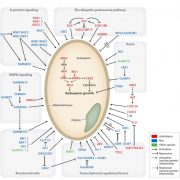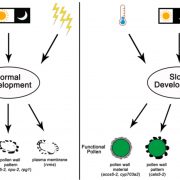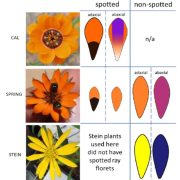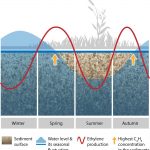Single-cell RNA-sequencing of Nicotiana attenuata corolla cells reveals the biosynthetic pathway of a floral scent (New Phytol.)
 Release of scents or volatile compounds influence pollinator preference for or localisation of many flora. In excess of 1,700 distinct floral scents have been classified to date, yet our understanding of biosynthetic processes associated with many scents is limited. Kang et al. recently determined the biosynthetic pathway associated with a wild tobacco volatile compound known as benzylacetone (BA). BA is released from Nicotiana attenuata in a diurnal pattern to attract pollinators. Through isolation of BA-releasing wild tobacco cells, subsequent single-cell RNA-sequencing and gene silencing, cellular actors regulating BA biosynthesis were identified. These actors include the epidermal enzyme phenylalanine ammonia-lyase 4 (NaPAL4) which commences BA biosynthesis and the MYB transcription factor NaODO1-like which may regulate BA biosynthetic genes. Reducing transcriptional heterogeneity by selecting BA-releasing cells, permitted the metabolite regulatory process to be targeted and delineated. This process may be extended beyond floral scent analysis to other useful plant metabolites going forward. (Summary by Orla Sherwood, @orlasherwood) New Phytol. 10.1111/NPH.17992
Release of scents or volatile compounds influence pollinator preference for or localisation of many flora. In excess of 1,700 distinct floral scents have been classified to date, yet our understanding of biosynthetic processes associated with many scents is limited. Kang et al. recently determined the biosynthetic pathway associated with a wild tobacco volatile compound known as benzylacetone (BA). BA is released from Nicotiana attenuata in a diurnal pattern to attract pollinators. Through isolation of BA-releasing wild tobacco cells, subsequent single-cell RNA-sequencing and gene silencing, cellular actors regulating BA biosynthesis were identified. These actors include the epidermal enzyme phenylalanine ammonia-lyase 4 (NaPAL4) which commences BA biosynthesis and the MYB transcription factor NaODO1-like which may regulate BA biosynthetic genes. Reducing transcriptional heterogeneity by selecting BA-releasing cells, permitted the metabolite regulatory process to be targeted and delineated. This process may be extended beyond floral scent analysis to other useful plant metabolites going forward. (Summary by Orla Sherwood, @orlasherwood) New Phytol. 10.1111/NPH.17992









